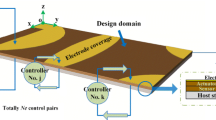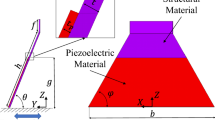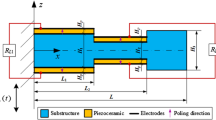Abstract
In this work, a novel multiscale topology optimization method has been proposed for the design of electromechanical energy-harvesting systems converting mechanical vibrations into electric currents made of non-piezoelectric materials. At the microscopic scale, the material is assumed to be periodic, porous, and flexoelectric, although not piezoelectric. A first step of topology optimization is performed, in order to maximize the effective (homogenized) flexoelectric properties of the material, where a flexoelectric homogenization model is first formulated. As a result, the effective material, although made of a non-piezoelectric material, has apparent piezoelectric properties. In a second step, these properties are used to model the behavior of a dynamic electromechanical energy-harvesting system structure. A second topology optimization step, this time performed at the structural scale, aims to maximize the system electromechanical coupling factor (ECF) for a given forced vibration frequency, including the micro-inertial effect. At both scales, an isogeometric analysis method is employed to solve the strain-gradient problems numerically. We show that the optimized structure obtained offers significant gains in terms of ECF (by a factor of between 2 and 20) compared with non-optimized structures of the same volume, over a wide range of excitation frequencies. The procedure could open up new possibilities in the design of energy recovery systems without the use of piezoelectric materials.









Similar content being viewed by others
References
Abdollahi A, Peco C, Millán D, Arroyo M, Arias I (2014) Computational evaluation of the flexoelectric effect in dielectric solids. J Appl Phys 116:093502. https://doi.org/10.1063/1.4893974
Abdollahi A, Millán D, Peco C, Arroyo M, Arias I (2015) Revisiting pyramid compression to quantify flexoelectricity: a three-dimensional simulation study. Phys Rev B 91:104103. https://doi.org/10.1103/PhysRevB.91.104103
Askes H, Aifantis EC (2009) Gradient elasticity and flexural wave dispersion in carbon nanotubes. Phys Rev B 80:195412. https://doi.org/10.1103/PhysRevB.80.195412
Askes H, Aifantis E (2011) Gradient elasticity in statics and dynamics: an overview of formulations, length scale identification procedures, finite element implementations and new results. Int J Solids Struct 48:1962–1990. https://doi.org/10.1016/j.ijsolstr.2011.03.006
Balamurugan R, Ramakrishnan C, Singh N (2008) Performance evaluation of a two stage adaptive genetic algorithm (tsaga) in structural topology optimization. Appl Soft Comput 8:1607–1624. https://doi.org/10.1016/j.asoc.2007.10.022
Bendsøe MP (1989) Optimal shape design as a material distribution problem. Struct Optim 1:193–202. https://doi.org/10.1007/BF01650949
Bendsøe MP, Kikuchi N (1988) Generating optimal topologies in structural design using a homogenization method. Comput Methods Appl Mech Eng 71:197–224. https://doi.org/10.1016/0045-7825(88)90086-2
Carl D (1978) A practical guide to splines. Springer, New York
Chen X, Yvonnet J, Yao S, Park H (2021) Topology optimization of flexoelectric composites using computational homogenization. Comput Methods Appl Mech Eng 381:113819. https://doi.org/10.1016/j.cma.2021.113819
Chen X, Yvonnet J, Park H, Yao S (2021) Enhanced converse flexoelectricity in piezoelectric composites by coupling topology optimization with homogenization. J Appl Phys 129:245104. https://doi.org/10.1063/5.0051062
Chen X, Yao S, Yvonnet J (2023) Dynamic analysis of flexoelectric systems in the frequency domain with isogeometric analysis. Comput Mech 71:353–366
Cholleti ER (2018) A review on 3d printing of piezoelectric materials. In: IOP conference series: materials science and engineering, vol. 455. IOP Publishing, p 012046
Codony D, Marco O, Fernández-Méndez S, Arias I (2019) An immersed boundary hierarchical b-spline method for flexoelectricity. Comput Methods Appl Mech Eng 354:750–782
Cottrell JA, Hughes TJ, Bazilevs Y (2009) Isogeometric analysis: toward integration of CAD and FEA. Wiley, Hoboken
Cuong-Le T, Nguyen KD, Hoang-Le M, Sang-To T, Phan-Vu P, Wahab MA (2022) Nonlocal strain gradient iga numerical solution for static bending, free vibration and buckling of sigmoid fg sandwich nanoplate. Phys B Condens Matter 631:413726. https://doi.org/10.1016/j.physb.2022.413726
Deng Q, Kammoun M, Erturk A, Sharma P (2014) Nanoscale flexoelectric energy harvesting. Int J Solids Struct 51:3218–3225. https://doi.org/10.1016/j.ijsolstr.2014.05.018
Deng F, Deng Q, Yu W, Shen S (2017) Mixed finite elements for flexoelectric solids. J Appl Mech 84:10
Fousek J, Cross L, Litvin D (1999) Possible piezoelectric composites based on the flexoelectric effect. Mater Lett 39:287–291. https://doi.org/10.1016/S0167-577X(99)00020-8
Gao J, Gao L, Luo Z, Li P (2019) Isogeometric topology optimization for continuum structures using density distribution function. Int J Numer Methods Eng 119:991–1017. https://doi.org/10.1002/nme.6081
Gao J, Wang L, Luo Z, Gao L (2021) Igatop: an implementation of topology optimization for structures using iga in matlab. Struct Multidisc Optim 64:1669–1700
Ghasemi TRH, Park HS (2017) A level-set based iga formulation for topology optimization of flexoelectric materials. Comput Methods Appl Mech Eng 313:239–258. https://doi.org/10.1016/j.cma.2016.09.029
Harris P (1965) Mechanism for the shock polarization of dielectrics. J Appl Phys 36:739–741
Hughes T, Cottrell J, Bazilevs Y (2005) Isogeometric analysis: cad, finite elements, nurbs, exact geometry and mesh refinement. Comput Methods Appl Mech Eng 194:4135–4195. https://doi.org/10.1016/j.cma.2004.10.008
Kogan S (1964) Piezoelectric effect during inhomogeneous deformation and acoustic scattering of carriers in crystals. Sov Phys Solid State 5:197–224
López J, Valizadeh N, Rabczuk T (2022) An isogeometric phase-field based shape and topology optimization for flexoelectric structures. Comput Methods Appl Mech Eng 391:114564. https://doi.org/10.1016/j.cma.2021.114564
Luh GC, Lin CY, Lin YS (2011) A binary particle swarm optimization for continuum structural topology optimization. Appl Soft Comput 11:2833–2844. https://doi.org/10.1016/j.asoc.2010.11.013
Mao S, Purohit P, Aravas N (2016) Mixed finite-element formulations in piezoelectricity and flexoelectricity. Proc Royal Soc A Math Phys Eng Sci 472:20150879
Maranganti R, Sharma N, Sharma P (2006) Electromechanical coupling in nonpiezoelectric materials due to nanoscale nonlocal size effects: green’s function solutions and embedded inclusions. Phys Rev B 74:014110
Mashkevich VS, Tolpygo KB (1957) Electrical, optical and elastic properties of diamond type crystals. Sov Phys JETP 5(3):435–439
Nanthakumar S, Zhuang X, Park H, Rabczuk T (2017) Topology optimization of flexoelectric structures. J Mech Phys Solids 105:217–234. https://doi.org/10.1016/j.jmps.2017.05.010
Nelli Silva E, Ono Fonseca J, de Espinosa FM, Crumm A, Brady G, Halloran J, Kikuchi N (1999) Design of piezocomposite materials and piezoelectric transducers using topology optimization-part i. Archiv Comput Methods Eng 6:117–182
Nghia-Nguyen T, Kikumoto M, Nguyen-Xuan H, Khatir S, Abdel Wahab M, Cuong-Le T (2023) Optimization of artificial neutral networks architecture for predicting compression parameters using piezocone penetration test. Exp Syst Appl 223:119832. https://doi.org/10.1016/j.eswa.2023.119832
Nguyen VP, Bordas S (2015) Extended isogeometric analysis for strong and weak discontinuities. Isogeometric methods for numerical simulation. Springer, Cham, pp 21–120
Nguyen B, Zhuang X, Rabczuk T (2018) Numerical model for the characterization of maxwell-wagner relaxation in piezoelectric and flexoelectric composite material. Comput Struct 208:75–91
Nguyen KD, Thanh CL, Vogel F, Nguyen-Xuan H, Abdel-Wahab M (2022) Crack propagation in quasi-brittle materials by fourth-order phase-field cohesive zone model. Theor Appl Fract Mech 118:103236. https://doi.org/10.1016/j.tafmec.2021.103236
Noh JY, Yoon GH (2012) Topology optimization of piezoelectric energy harvesting devices considering static and harmonic dynamic loads. Adv. Eng. Softw. 53:45–60. https://doi.org/10.1016/j.advengsoft.2012.07.008
Rahmati AH, Yang S, Bauer S, Sharma P (2019) Nonlinear bending deformation of soft electrets and prospects for engineering flexoelectricity and transverse (d 31) piezoelectricity. Soft Matter 15:127–148
Rao R (2016) Jaya: A simple and new optimization algorithm for solving constrained and unconstrained optimization problems. Int J Ind Eng Comput 7:19–34
Rozvany GI, Zhou M, Birker T (1992) Generalized shape optimization without homogenization. Struct Optim 4:250–252
Rupp CJ, Evgrafov A, Maute K, Dunn ML (2009) Design of piezoelectric energy harvesting systems: a topology optimization approach based on multilayer plates and shells. J Intell Mater Syst Struct 20:1923–1939
Sang-To T, Le-Minh H, Abdel Wahab M, Thanh CL (2023) A new metaheuristic algorithm: Shrimp and goby association search algorithm and its application for damage identification in large-scale and complex structures. Adv Eng Softw 176:103363. https://doi.org/10.1016/j.advengsoft.2022.103363
Sharma N, Maranganti R, Sharma P (2007) On the possibility of piezoelectric nanocomposites without using piezoelectric materials. J Mech Phys Solids 55:2328–2350
Shen S, Hu S (2010) A theory of flexoelectricity with surface effect for elastic dielectrics. J Mech Phys Solids 58:665–677
Silva ECN, Kikuchi N (1999) Design of piezoelectric transducers using topology optimization. Smart Mater Struct 8:350. https://doi.org/10.1088/0964-1726/8/3/307
Silva EN, Nishiwaki S, Kikuchi N (1999) Design of piezocomposite materials and piezoelectric transducers using topology optimization-part ii. Archiv Comput Methods Eng 6:191–215
Svanberg K (2002) A class of globally convergent optimization methods based on conservative convex separable approximations. SIAM J Optim 12:555–573. https://doi.org/10.1137/S1052623499362822
Thai T, Rabczuk T, Zhuang X (2018) A large deformation isogeometric approach for flexoelectricity and soft materials. Comput Methods Appl Mech Eng 341:718–739
Tran VT, Nguyen TK, Nguyen-Xuan H, Abdel Wahab M (2023) Vibration and buckling optimization of functionally graded porous microplates using bcmo-ann algorithm. Thin-Wall Struct 182:110267
Wang L, Hu H (2005) Flexural wave propagation in single-walled carbon nanotubes. Phys Rev B 71:195412. https://doi.org/10.1103/PhysRevB.71.195412
Wang MY, Wang X, Guo D (2003) A level set method for structural topology optimization. Comput Methods Appl Mech Eng 192:227–246. https://doi.org/10.1016/S0045-7825(02)00559-5
Wang B, Gu Y, Zhang S, Chen L-Q (2019) Flexoelectricity in solids: progress, challenges, and perspectives. Prog Mater Sci 106:100570
Xie Y, Steven G (1993) A simple evolutionary procedure for structural optimization. Comput Struct 49:885–896. https://doi.org/10.1016/0045-7949(93)90035-C
Yuan XY, Wu D (2009) Atomic simulations for surface-initiated melting of nb(111). Trans Nonferrous Metals Soc Chin 19:210–214. https://doi.org/10.1016/S1003-6326(08)60254-X
Yudin PV, Tagantsev AK (2013) Fundamentals of flexoelectricity in solids. Nanotechnology. https://doi.org/10.1088/0957-4484/24/43/432001
Yvonnet J, Liu L (2017) A numerical framework for modeling flexoelectricity and maxwell stress in soft dielectrics at finite strains. Comput Methods Appl Mech Eng 313:450–482. https://doi.org/10.1016/j.cma.2016.09.007
Yvonnet J, Chen X, Sharma P (2020) Apparent flexoelectricity due to heterogeneous piezoelectricity. J Appl Mech 87:111003
Zhang Z, Li Y, Zhou W, Chen X, Yao W, Zhao Y (2021) Tonr: An exploration for a novel way combining neural network with topology optimization. Comput Methods Appl Mech Eng 386:114083. https://doi.org/10.1016/j.cma.2021.114083
Zhang W, Yan X, Meng Y, Zhang C, Youn SK, Guo X (2022) Flexoelectric nanostructure design using explicit topology optimization. Comput Methods Appl Mech Eng 394:114943. https://doi.org/10.1016/j.cma.2022.114943
Zhu W, Fu J, Li N, Cross L (2006) Piezoelectric composite based on the enhanced flexoelectric effects. Appl Phys Lett 89:192904
Zhuang X, Nguyen BH, Nanthakumar SS, Tran TQ, Alajlan N, Rabczuk T (2020) Computational modeling of flexoelectricity-a review. Energies. https://doi.org/10.3390/en13061326
Zubko P, Catalan G, Buckley A, Welche PRL, Scott JF (2007) Strain-gradient-induced polarization in srtio3 single crystals. Phys Rev Lett 99:167601. https://doi.org/10.1103/PhysRevLett.99.167601
Zubko P, Catalan G, Tagantsev A (2013) Flexoelectric effect in solids. Ann Rev Mater Res 43:387–421. https://doi.org/10.1146/annurev-matsci-071312-121634
Acknowledgements
Xing Chen acknowledges the support from China Scholarship Council (CSC No. 202106370116).
Author information
Authors and Affiliations
Corresponding author
Ethics declarations
Conflict of interest
On behalf of all authors, the corresponding author states that there is no conflict of interest.
Replication of results
Results can be made available on reasonable request to the corresponding author.
Additional information
Responsible Editor: Kai James
Publisher's Note
Springer Nature remains neutral with regard to jurisdictional claims in published maps and institutional affiliations.
Appendices
Appendix A
1.1 Matrices of material and IGA discretization
\(B_\phi\), \(B_u\) and \(H_u\) are the matrices containing the gradient and Hessian of the corresponding basis functions \(N_\phi\) and \(N_u\) which are given by
The material parameters \(\textbf{C}\), \({\varvec{\alpha }}\), \({\varvec{e}}\), \({\varvec{\mu }}\) and \(\textbf{G}\) are defined in the 2D matrix form as
Appendix B
1.1 Calculation of effective flexoelectric tensor
The strain and electric fields solutions, strain gradient fields solutions of the problem Eq. (3) can be expressed as the functions of the effective strain, electric and strain gradient fields as
We define the displacement and electric fields matrices:
The displacement fields \(\textbf{u}^i\) and the electric fields \({\varvec{\phi }}^i\) are the vector columns containing, respectively, the nodal displacement and electric potentials solution of the localization problems Eqs. (3) with the boundary conditions described in Table 5.
The matrices associated with the tensors \(A^0\), \(B^0\), \(A^1\), \(D^0\), \(A^0\), \(h^0\), \(D^1\), \(J^0\), \(Q^0\) and \(J^1\) in Eqs. (B1)–(B3) can be computed according to
Substituting Eqs. (B7)–(B9) into Eq. (14), we have the effective flexoelectric tensor in matrix form as
Appendix C
1.1 Sensitivity analysis
To solve the effective flexoelectric coefficients enhancement problem in Eq. (54) for microstructure and the electromechanical coupling efficiency optimization problem Eq. (56) for energy harvester based on the gradient-based mathematical programming method, the adjoint method is employed to derive both the numerical sensitivities.
1.1.1 Microstructure analysis
The effective flexoelectric tensor can be written by compact form as
We define
By using the adjoint method, the corresponding Lagrangian \(L^m\) for the effective flexoelectric tensor components optimization problem Eq. (54) is formed by introducing adjoint vectors \(\lambda ^{m}_1\) and \(\lambda ^m_2\) as:
Where \(\textbf{V}^T\textbf{K}_G-{\textbf{F}_V}^T=0\) and \(\textbf{K}_G\textbf{W}-{\textbf{F}_W}^T=0\) are the IGA discrete forms of Eq. (11) with boundary condition shown in Table 5, and they hold for arbitrary vectors \(\lambda ^{m}_1\) and \(\lambda ^m_2\). Differentiating the Lagrangian \(L^m\) with respect to the design variable \(\rho ^m\) gives:
We finally obtain the adjoint sensitivity of effective flexoelectric components with respect to the density as
1.1.2 Energy harvester analysis
For the energy harvester in dynamics, the first derivative of the objective function J with respect to the nodal design variable \(\rho _{i,j}\) is calculated as
The terms \(\frac{\partial \Pi _m}{\partial \rho _{i,j}}\) and \(\frac{\partial \Pi _e}{\partial \rho _{i,j}}\) are derived by chain rules, respectively,
Furthermore, \(\frac{\partial \Pi _m}{\partial \bar{\bar{\rho }}_{i,j}}\) and \(\frac{\partial \Pi _e}{\partial \bar{\bar{\rho }}_{i,j}}\) is explicit calculated by introducing an adjoint vector \({\varvec{\lambda }}^c\) and \({\varvec{\lambda }}^e\), respectively. The corresponding Lagrangian equations are constructed as:
where the discrete system of coupling equilibrium equation \(\textbf{K}_{tot}\textbf{U}_{tot}=\textbf{F}_{tot}\) is defined in Eq. (52), while \(\overline{\textbf{K}_{tot}\textbf{U}_{tot}}=\overline{\textbf{F}_{tot}}\) is the corresponding conjugate counterpart. Both equilibrium equations hold for arbitrary \({\varvec{\lambda }}^c\) and \({\varvec{\lambda }}^e\). The sensitivities of the Lagrangian equations with respect to \(\bar{\bar{\rho }}_{i,j}\) are written as
We finally obtain the sensitivities of mechanical and electrical energy w.r.t \(\bar{\bar{\rho }}_{i,j}\),
where \(Re\left\{ \cdot \right\}\) mean the real part of the complex. The adjoint vectors are calculated by the following adjoint equations
To solve the adjoint equations, we can use the same mechanical and electric boundary condition as the problem Eq. (58). The derivatives of material density distribution field \(\bar{\bar{\rho }}\) with respect to nodal density field \(\rho\) presented in Eq. (C7), (C8) can be obtained as
Substituting Eqs. (C13), (C14)–(C19), (C20) into Eqs. (C7) and (C8), finally into Eq. (C6), the explicit sensitivity of objection function with respect to nodal density variable \(\rho\) can therefore be obtained.
Rights and permissions
Springer Nature or its licensor (e.g. a society or other partner) holds exclusive rights to this article under a publishing agreement with the author(s) or other rightsholder(s); author self-archiving of the accepted manuscript version of this article is solely governed by the terms of such publishing agreement and applicable law.
About this article
Cite this article
Chen, X., Yao, S. & Yvonnet, J. Multiscale topology optimization of an electromechanical dynamic energy harvester made of non-piezoelectric material. Struct Multidisc Optim 67, 66 (2024). https://doi.org/10.1007/s00158-024-03787-x
Received:
Revised:
Accepted:
Published:
DOI: https://doi.org/10.1007/s00158-024-03787-x




